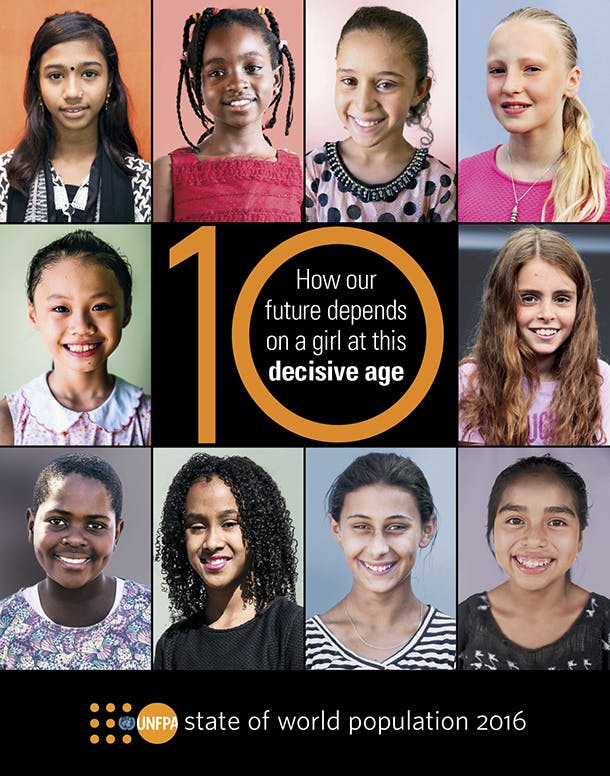
Aditi, Hiba, Tuong Anh, and Temawelase want to grow up to be a teacher. They are all 10-year-old girls from different corners of the world – Bangladesh, Jordan, Vietnam, and Swaziland – but share the same dream for their future.
They represent the more than 60 million 10-year-old girls around the world – the vast majority of them living in developing countries – who are considered the Sustainable Development Goals (SDGs) generation.
Why? Because if we fail these 10-year-old girls we will fail in achieving the Sustainable Development Goals in 2030 when these girls will turn 25.

Today, the UN Population Fund (UNFPA) launches its report “10: How our future depends on a girl at this decisive age” and takes a closer look at the status of 10-year-olds and how we as a global community can help ignite their potential. I asked Sarah Craven, the head of UNFPA’s Washington office, to share some of the key findings with us:
Tell us about the report. What inspired the topic?
UNFPA’s State of the World Population report shows that our collective future depends on how we support the world’s 60 million 10-year-old girls today as they start their journey from adolescence to adulthood.
Today’s 10-year-old girls are at the starting point for achieving the Sustainable Development Goals. The real test of success of the SDGs is whether a 10-year-old girl today is healthy, educated, and productive 15 years from now.
What are some of the unique challenges 10-year-old girls face?
At 10, a girl is approaching puberty when many in her community start to think of her as a commodity that may be bought, sold or traded – for work, childbearing, or sex.
Every day, 47,700 girls are forced into marriage. With marriage often comes pregnancy, and with early pregnancy come health risks and an end to a girl’s education, undermining her prospects for a job, an income, or independence. This could lead to a lifetime of barriers, poverty, powerlessness, and lost opportunities, unless we work together to turn the tide.
What is UNFPA doing to support 10-year-old girls around the world?
UNFPA is investing in programs designed to enhance the health, safety, education, and rights of girls. UNFPA’s Action for Adolescents Girls program, for example, aims to protect marginalized girls’ rights, delay marriage and pregnancy, and elevate their status in the community. The program is providing adolescent girls, some as young as 10, with opportunities for social participation and leadership, life-skills training and literacy, access to health care, and age-appropriate sexual and reproductive information.
Why is advancing the rights of 10-year-old girls critical to achieving the Sustainable Development Goals?
Building a brighter future for girls makes a brighter future for everyone. In 15 years, the lifespan of the SDGs, the 10-year-old girl will be 25. The true test of success will be if that girl is still left behind or if she is enjoying her human rights and wellbeing, and exploring the many opportunities open to her, knowing that, when her own children turn 10, they will have the same opportunities.
Why is comprehensive sexuality education so critical for adolescents?
Comprehensive sexuality education is a critical source of age-appropriate information for millions of girls and boys around the world. At age 10, a girl may already have gone through puberty, and in some parts of the world, be considered ready for marriage and childbearing. An understanding of her own body is critical to a girl as she enters adolescence. Comprehensive sexuality education has a demonstrated impact on reducing unintended pregnancy and sexually transmitted infections, including HIV. It also empowers girls with knowledge and self-esteem.
Some of the barriers adolescent girls face have to do with norms that are established in communities for decades. How do we get at some of these root causes and strive for long-term change?
As she enters adolescence, a girl quickly begins to understand her place, often subordinate, in her community. One important strategy is to engage with girls via empowerment programs so they can have a positive view of themselves and their potential. Another strategy is to involve the entire community surrounding the 10 year old girl – parents, teachers, community leaders – to ensure that positive norms support girls instead of holding them back.
In Western Kenya, for example, parents started ensuring that their daughters stayed in school when they saw the economic and health benefits of education. Champions of positive norms such as faith leaders can be powerful and convincing voices for change.
How can individuals get involved?
The report outlines 10 essential actions for 10-year-old girls ranging from providing safe, high-quality education to engaging girls and boys, and all the people around them, in challenging gender norms.
The Sustainable Development Goals apply to everyone. Everyone has a stake in speaking out, investing in and empowering 10-year-old girls in their local communities. No country in the world can claim that it delivers all rights and opportunities to which the 10-year old girl is entitled. All of us have work to do.
To learn more about Aditi, Hiba, Tuong Anh, and Temawelase and how you can help, visit the UNFPA website. And to support to the work of UNFPA, you can donate via UNFPA’s 501(c)(3) non-profit partner, Friends of UNFPA.
[Photo: UNFPA]



 View All Blog Posts
View All Blog Posts